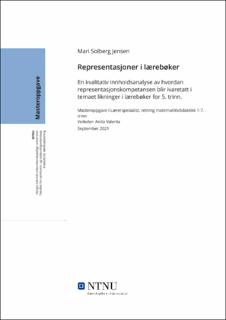| dc.contributor.advisor | Valenta, Anita | |
| dc.contributor.author | Jensen, Mari Solberg | |
| dc.date.accessioned | 2023-04-18T17:19:33Z | |
| dc.date.available | 2023-04-18T17:19:33Z | |
| dc.date.issued | 2021 | |
| dc.identifier | no.ntnu:inspera:90243908:44330721 | |
| dc.identifier.uri | https://hdl.handle.net/11250/3063657 | |
| dc.description.abstract | Denne studien har undersøkt representasjoner i lærebøker på 5. trinn. Hensikten har vært har vært å få innsikt i hvordan oppgaver og eksempler i lærebøkene ivaretar de ulike aspektene ved representasjonskompetansen. En slik innsikt vil kunne øke læreres bevissthet omkring representasjoner generelt og mer spesifikt om læreboka er et hjelpemiddel som bidrar til å til å utvikle elevenes representasjonskompetanse. Studiens forskningsspørsmål er: På hvilken måte ivaretar lærebøker på 5. trinn representasjonskompetansen i temaet likninger?
Studien har benyttet metoden kvalitativ innholdsanalyse og har analysert oppgaver og eksempler i kapittelet om likninger i tre lærebøker for 5. trinn. Datamaterialet ble analysert, ved å bruke en bearbeidet utgave av et analyseskjema, funnet hos Charalambous et al. (2010), som består av en horisontal og en vertikal analyse. I den horisontale analysen ble lærebøkene undersøkt på et overordnet nivå. Den vertikale analysen undersøkte kapitlene om likninger i hver lærebok, for å analysere de ulike aspektene i representasjonskompetansen, og er delt i fem delanalyser. Delanalysene var både deduktive og induktive, avhengig av om koder og kategorier var forhåndsdefinerte på bakgrunn av eksisterende teori eller ble utarbeidet gjennom analyse av data og senere samlet i kategorier. Som rammeverk har studien tatt utgangspunkt i Niss og Jensen (2002) for å definere begrepet representasjonskompetanse i undersøkelsen. For å undersøke hvordan representasjonskompetansen ble ivaretatt , ble Duval (2006) sitt rammeverk for semiotiske representasjonssystemer brukt for å predefinere koder i de deduktive delene av analysen. Mer bestemt for å beskrive representasjonene i lærebøkene og transformasjoner mellom representasjonssystemer.
Den horisontale analysen viser at det ikke er store forskjeller mellom lærebøkene på et overordnet og strukturelt plan. Delanalysene i den vertikale analysen, viser at lærebøkene ivaretar representasjonskompetansen, ved å kommunisere ulike, hensiktsmessige representasjoner, elevene kan bruke som verktøy i tankeprosessen, og for å kommunisere en løsning. For å representere likninger og støtte innlæring av algebraiske symboler, bruker lærebøkene alternative representasjoner, eksempelvis balansemodeller. Elevene må i hovedsak bruke symboler eller naturlig språk for å kommunisere en løsning, men kan bruke de øvrige representasjonssystemene vi finner i læreboka i tankeprosessen. Lærebøkene legger også til rette for at elevene må oversette mellom representasjonssystemer. Samtidig viser studien at elevene får få muligheter til å velge representasjoner selv. Lærebøkene stiller heller ikke eksplisitte spørsmål gir elevene mulighet til å reflektere over sammenhengen mellom representasjoner og representasjonenes egenskaper. Når lærebøkene ikke ivaretar alle aspektene ved representasjonskompetansen like tydelig, indikerer det at lærere bør kompensere for aspektene læreboka ikke dekker.
Nøkkelord: lærebøker i matematikk, lærebokanalyse, representasjoner, representasjonskompetanse, likninger | |
| dc.description.abstract | This study has examined representations in textbooks in 5th grade. The purpose of the study has been to gain insight in how assignments and examples in textbooks, support different aspects of the representational competence. This insight can increase teacher’s awareness about representations in general, and more specific if the textbook is a tool which contribute to develop student’s representational competence. The research question is: In what way do 5. grade textbooks support representational competence in the topic equations?
The study has used qualitative content analysis method and has analysed assignments and examples in the equation chapter in three 5th grade textbooks. The data was analysed by using a modified version of an analysis form, found in Charalambous et al. (2010), consisting of a horizontal and a vertical analysis. In the horizontal analysis, the textbooks were investigated on a general level. The vertical analysis studied the equation chapters in each textbook, by analysing different aspects in the representational competence, and was divided into five sub-analyses. The sub-analyses were both deductive and inductive, depending on if codes and categories were pre-defined based on existing theory, or was developed throughout the analysis and later grouped in categories. As framework, the study has used Niss and Jensen (2002) to define the concept representational competence. To investigate in what way representational competence was supported, Duval’s (2006) framework for semiotic representations, was used to predefine codes and categories in the deductive analyses. More specific to describe the representations in textbooks and transformations between representational systems.
The horizontal analysis shows that there are few differences between the textbooks on a general and structural level. The sub-analysis shows that textbooks support the representational competence, by communicating different, meaningful representations the students can use both as tools for understanding and to communicate a solution. To represent equations and support understanding of algebraic symbols, the textbooks present alternative representations, for example balance models. Students must mainly use symbols or natural language to communicate a solution but can use other representational systems from the textbook as tools. The textbooks also facilitate opportunities to translate between representational systems. At the same time, this study shows that students are given few opportunities to choose which representations to use themselves. The textbooks do not ask questions that make the students reflect upon connections between representations and representations’ possibilities and limitations. When textbooks do not support all aspects of representational competence, this indicates that teachers must compensate for what the textbook do not cover.
Keywords: mathematics textbooks, textbook analysis, representations representational competence, equations | |
| dc.language | nob | |
| dc.publisher | NTNU | |
| dc.title | Representasjoner i lærebøker | |
| dc.type | Master thesis | |
